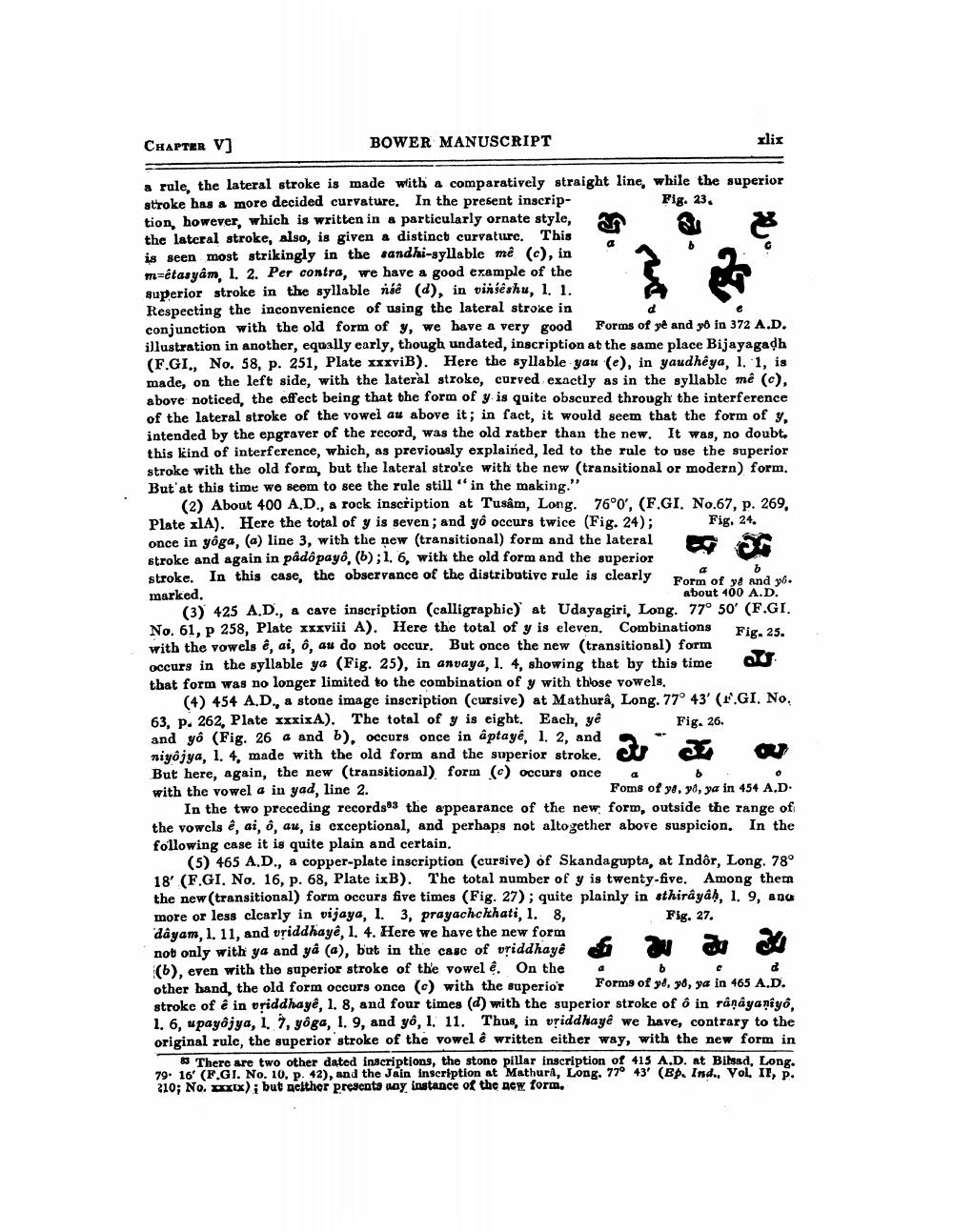________________
CHAPTER V]
BOWER MANUSCRIPT
xlis
-
5
a rule, the lateral stroke is made with a comparatively straight line, while the superior stroke has a more decided curvature. In the present inscrip
Fig. 23 tion, however, which is written in a particularly ornate style, the lateral stroke, also, is given a distinct curvature. This is seen most strikingly in the sandhi-syllable mê (c), in m=étasyam, 1. 2. Per contra, we have a good example of the superior stroke in the syllable rsê (d), in vinseshu, 1. 1. Respecting the inconvenience of using the lateral stroke in conjunction with the old form of y, we have a very good forms of ye and y0 in 372 A.D. illustration in another, equally early, though undated, inscription at the same place Bijayagadh (F.GI., No. 58, p. 251, Plate xxxviB). Here the syllable you (e), in yaudhéya, 1. 1, is made, on the left side, with the lateral stroke, curved exactly as in the syllable mê (c), above noticed, the effect being that the form of y.is quite obscured through the interference of the lateral stroke of the vowel au above it; in fact, it would seem that the form of y, intended by the epgraver of the record, was the old rather than the new. It was, no doubt. this kind of interference, which, as previously explained, led to the rule to use the superior stroke with the old form, but the lateral stroke with the new (transitional or modern) form. But at this time we seem to see the rule still " in the making."
(2) About 400 A.D., a rock inscription at Tusâm, Long. 76°0', (F.GI, No.67, p. 269, Plate xlA). Here the total of y is seven, and yô occurs twice (Fig. 24); Fig. 24. once in yôga, (a) line 3, with the new (transitional) form and the lateral stroke and again in pådô payo, (b); 1.6, with the old form and the superior stroke. In this case, the observance of the distributive rule is clearly
19 Cacary Form of ye and yo.
a marked.
about 400 A.D. (3) 425 A.D., a cave inscription (calligraphic) at Udayagiri, Long. 77° 50' (F.GI. No. 61, p 258, Plate xxxviii A). Here the total of y is eleven. Combinations Fig. 25. with the vowels e, ai, ô, au do not occur. But once the new (transitional) form occurs in the syllable ya (Fig. 25), in anvaya, 1. 4, showing that by this time that form was no longer limited to the combination of y with those vowels.
(4) 454 A.D., a stone image inscription (cursive) at Mathura, Long. 77° 43' (F.GI, No. 63, p. 262, Plate xxxixA). The total of y is eight. Each, yê
Fig. 26. and yô (Fig. 26 4 and b), occurs once in aptayé, 1, 2, and niyojya, I. 4, made with the old form and the superior stroke. U But here, again, the new (transitional) form (c) occurs once with the vowel a in yad, line 2.
Foms of yo, y8, ya in 454 A.DIn the two preceding records83 the appearance of the new form, outside the range of the vowels e, ai, ê, au, is exceptional, and perhaps not altogether above suspicion. In the following case it is quite plain and certain.
(5) 465 A.D., a copper-plate inscription (cursive) of Skandagupta, at Indôr, Long. 78° 18' (F.GI. No. 16, p. 68, Plate ixB). The total number of y is twenty-five. Among them the new (transitional) form occurs five times (Fig. 27); quite plainly in sthirayah, 1. 9, ana more or less clearly in vijaya, 1. 3, prayachchhati, 1. 8,
Fig. 27. dayam, 1. 11, and vriddhaye, 1. 4. Here we have the new form not only with ya and ya (a), but in the case of vriddhayê
20 (6), even with the superior stroke of the vowel e. On the a other hand, the old form occurs once (c) with the superior F orms of yé, 98, ya in 465 A.D. stroke of ê in uriddhaye, 1. 8, and four times (d) with the superior stroke of ô in rânayaniyo, 1. 6, upayôjya, 1.7, yôga, 1. 9, and yo, 1. 11. Thus, in vriddhayê we have, contrary to the original rule, the superior stroke of the vowel ê written either way, with the new form in
There are two other dated inscriptions, the stone pillar inscription of 415 A.D. at Bitsad, Long. 79. 16' (F.GI. No. 10, P. 42), and the Jain inscription at Mathura, Long. 77° 43' (Bp. Ind. Vol. II, p. 210; No. XXX); but neither presenta uoy instance of the new form,




